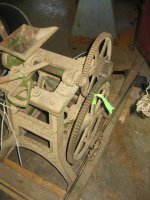Colin Caissie
Plastic
- Joined
- Sep 10, 2014
New to the forum. Maybe this isn't the exact place to discuss the design challenge, but at least you get to look at a cool machine. Should I post elsewhere?
It is a two man hand powered rice huller from Japan, and is impossible to find anymore. There are copies manufactured in India, but the cost to import them is crazy.
The Maine Rice Project has queried me to build 10 units, and right away I figure the crux will be the drive train which is cast gearing...prohibitive cost for a run of ten units. My specific query involves the limits of chain speed.
The main hand crank input is about 75 rpm, raised by the first combo (112:17) to about 500 and final combo (96:17) to hit 2800. Planning on #40 chain.
Other than 120 degree wrap on the small sprockets, increased center distance of the sprockets and the notion to use a tensioner on the final chain combo, any impressions?
I figure chain will give me the efficiency I need without the high cost of custom gears. Looking for alternate ideas, also.
Any impressions?
It is a two man hand powered rice huller from Japan, and is impossible to find anymore. There are copies manufactured in India, but the cost to import them is crazy.
The Maine Rice Project has queried me to build 10 units, and right away I figure the crux will be the drive train which is cast gearing...prohibitive cost for a run of ten units. My specific query involves the limits of chain speed.
The main hand crank input is about 75 rpm, raised by the first combo (112:17) to about 500 and final combo (96:17) to hit 2800. Planning on #40 chain.
Other than 120 degree wrap on the small sprockets, increased center distance of the sprockets and the notion to use a tensioner on the final chain combo, any impressions?
I figure chain will give me the efficiency I need without the high cost of custom gears. Looking for alternate ideas, also.
Any impressions?




 )
)
